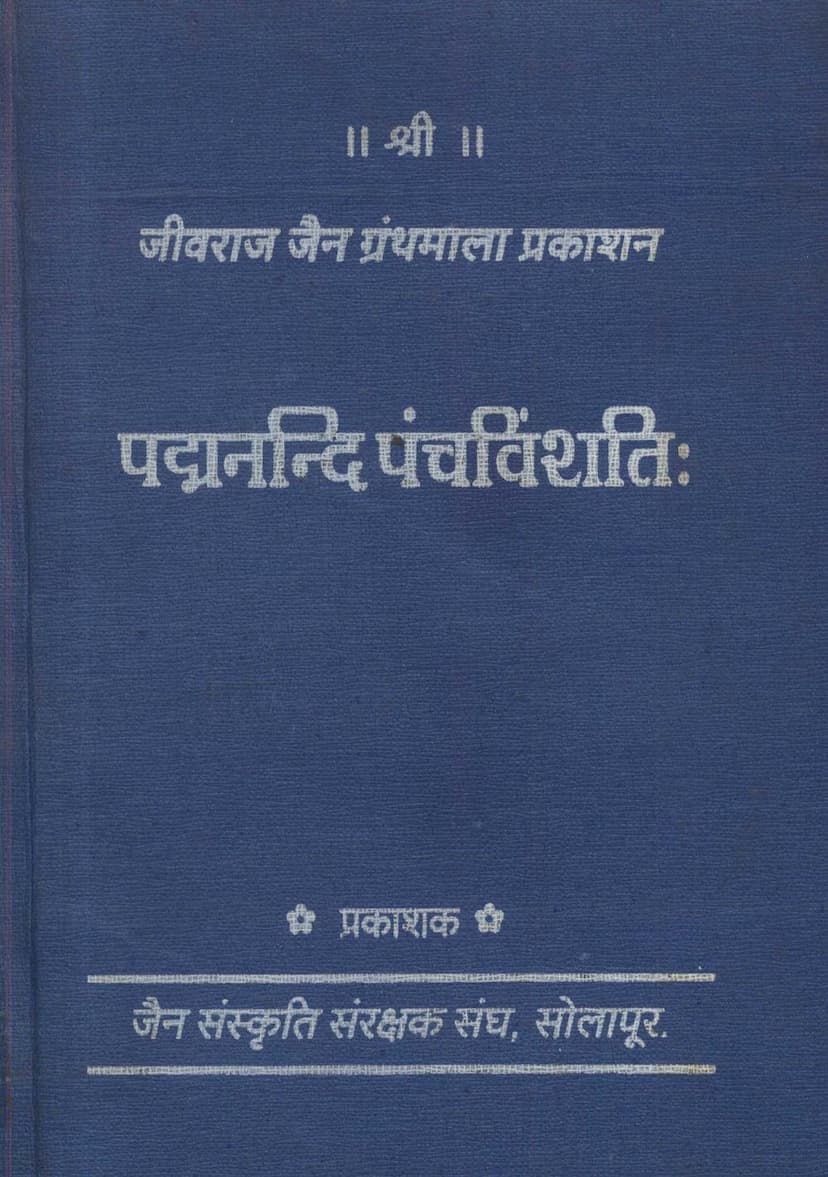Padmanandi Panchvinshti
Added to library: September 2, 2025

Summary
Here's a comprehensive summary of the Jain text "Padmanandi Panchvinshti" based on the provided pages:
Title: Padmanandi Panchvinshti (A Collection of Twenty-six Prakaranas Dealing with Religio-Didactic Themes)
Author: Padmanandi (authorship of all 26 prakaranas is attributed to him, though 4 are anonymous, they share thematic and stylistic similarities)
Editor/Translator: Pt. Balachandra Siddhanta Shastri
Publisher: Jain Sanskruti Samrakshak Sangh, Solapur
Publication Details: Jivaraja Jaina Granthamala, No. 10, Veera Samvat 2527 / A.D. 2001 (Third Edition)
Overview:
The "Padmanandi Panchvinshti" is a significant Jain religious and didactic text presented as a compilation of twenty-six independent "prakaranas" (small tracts or essays). These prakaranas cover a wide range of Jain religious and ethical themes, from philosophical expositions on the nature of the soul and reality to devotional hymns and moral instructions for laymen and monks. The work has enjoyed continuous popularity for nearly a thousand years, with references and quotations found from various Sanskrit and Prakrit writers starting from the 12th century.
Structure and Content:
The work, in its current form, comprises 26 distinct sections, each with its own title, though the collective title "Panchvinsati" (meaning twenty-five) suggests a later addition of at least one tract. The collection includes:
- Religio-Didactic Themes: The majority of the prakaranas focus on explaining Jain dharma. This includes discussions on:
- Dharma: Its various meanings, including compassion, duties for laymen and monks, the three jewels (Right Faith, Right Knowledge, Right Conduct), and the tenfold dharma (uttama kshama, etc.).
- Ethics and Morality: Emphasis is placed on giving up attachment, controlling passions and possessions, the importance of human birth for penance, and living a virtuous life.
- Specific Duties: Detailed manuals on householder's dharma (Upasaka Samskara), the career of a layman (Desavrata Uddyotana), and instructions on charity (Danopadesa).
- Transitoriness: The impermanent nature of the body, relationships, and worldly pleasures is highlighted, advising detachment and devotion to dharma (Anitya Panchashat).
- Spiritual Realization: The nature of the sentient real (Atman/Cit-tattva), the path to liberation through meditation and self-realization, and overcoming delusion are central themes (Ekatva Saptati, Nischaya Panchashat, Paramartha Vimsati).
- Asceticism: The qualities and reflections on monks (Yati Bhavana Ashtakam), the importance of celibacy (Brahmacharya Rakshavarti), and the rigorous practice of basic ascetic virtues are discussed.
- Devotional Hymns (Stuti): Several prakaranas are prayers or hymns dedicated to:
- The Siddhas (liberated souls), praising their status, achievements, and qualities (Siddha Stuti).
- The first Tirthankara, Rishabha, including biographical details and his glories (Rishabha Stotram).
- The Jina in general, often at the sight of an image (Darshana Stuti).
- Śruta-devata (the goddess of scripture) who bestows wisdom and poetic faculty.
- The twenty-four Tirthankaras, each stanza praying to one (Svayambhū Stuti).
- Shantinatha, the sixteenth Tirthankara, known as the Lord of Peace.
- The Jina in worship, detailing the items offered during puja (Sri Jinapuja Ashtakam).
- Soliciting divine mercy (Sri Karuna Ashtakam).
- A concluding recitation or appendix (Kriya Kanda Culika).
- Prakrit Hymns: Two prakaranas (XIII and XIV) are noted as being composed in Prakrit.
Authorship and Age:
- The work is attributed to Padmanandi, who is described as a pious and outstanding monk, often qualified by terms like bhavya, muni, yatindra, and suri. His guru is mentioned as Viranandi.
- The dating of Padmanandi is based on external evidence, including references in later works and inscriptions. External evidence suggests the work was produced in the Karnataka region, possibly between 1016 and 1136 AD, with the latter date being more probable if the author and a Kannada commentator are considered identical.
Key Themes and Contributions:
- Dharma as Liberation: The central message is that dharma, particularly the practice of the three jewels and ascetic virtues, is the path to liberation (moksha).
- Importance of the Soul: The unique and eternal nature of the sentient soul (Atman/Cit-tattva) is emphasized, separate from the body and karma, and its realization is the ultimate goal.
- Balance of Vyavahara and Nischaya Nayas: The text discusses both the practical, conventional (Vyavahara) aspects of dharma for lay followers and the ultimate, absolute (Nischaya) truth of the soul's nature.
- Moral Instruction: The importance of compassion, self-restraint, giving up attachments, the transience of life, and the dangers of vices like attachment and passions are stressed.
- Devotional Emphasis: The text highlights the power of devotion (bhakti) towards the Jinendras as a means of spiritual progress, especially in the current age when rigorous practices are difficult.
- Literary Merit: The language is primarily Sanskrit, with a simple, lucid, and elucidative style. The devotional hymns are noted for their poetic quality.
Sanskrit Commentary:
An anonymous Sanskrit commentary is included in the edition. However, it is described as generally "loose" in its Sanskrit expression, mixed with Hindi, and often explains minor details while passing over major difficulties. The commentary is considered more of a novice's jotting than a deeply studied exposition.
Hindi Translation/Commentary:
The edition includes a Hindi translation and commentary by Pt. Balachandra Siddhanta Shastri, which aims to make the work useful and interesting for scholars and devout readers.
Significance:
The Padmanandi Panchvinshti serves as a valuable repository of Jain teachings, offering guidance on ethical conduct, spiritual practice, and devotional worship. Its enduring popularity underscores its relevance and the profound impact of Padmanandi's spiritual and literary contributions to Jain literature.